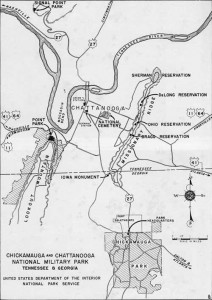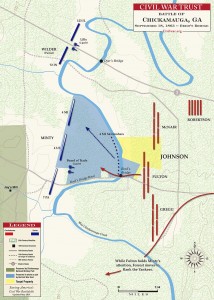The Chickamauga Battle was three days long, September 18 – 20, with each day having a distinctive character. Now that I have written about all the background stuff, I can proceed to the actual battle.
 But first: I talked to a friend today who was not able to understand the geography of the area from my previous posts. So I am including a map similar to the one we give out in the Visitors Center. You will probably have to double-click on it to see any details, but it should give you an idea of the varied areas for the battles ahead. Chickamauga is in the lower right corner with Lookout Mountain and Missionary Ridge more to the center of the map. Chickamauga is in Georgia and Point Park is in Tennessee.
But first: I talked to a friend today who was not able to understand the geography of the area from my previous posts. So I am including a map similar to the one we give out in the Visitors Center. You will probably have to double-click on it to see any details, but it should give you an idea of the varied areas for the battles ahead. Chickamauga is in the lower right corner with Lookout Mountain and Missionary Ridge more to the center of the map. Chickamauga is in Georgia and Point Park is in Tennessee.
Now, back to my story. You may remember that General Rosecrans and the Union Army had maneuvered in such a way that General Bragg and the Confederate Army left Chattanooga. Rosecrans thought that the Confederate Army was running all the way to Atlanta. But Bragg had decided to make a stand at West Chickamauga Creek. The creek was a natural barrier: deep and wide with steep sides. There were only three bridges across and a couple of places to ford, so it would take an army time to get across in either direction.
Rosecrans realized that the Confederate Army was organizing and preparing to attack. The Union Army had split into three divisions in order to pursue the Confederates when Rosecrans thought they were retreating. If the Confederates were planning to attack, Rosecrans needed to unite his army and get it set up for battle. But in order to do that, he needed to know exactly where the Confederate Army was.
You may think it would be hard to hide an army, but the terrain around Chickamauga is hilly and heavily wooded. So Rosecrans sent out Wilder’s Lightning Brigade on September 18, 1863 to find the Confederate Army. They could move swiftly, being mounted, but they also had the Spencer repeating rifles so they could hold off a section of the army if they had to. Rosecrans also sent out Colonel Robert Minty’s Calvary Brigade for the same purpose.
 On the afternoon of September 18, Wilder’s Lightning Brigade found the Confederate Army massed across Chickamauga Creek. Parts of the Confederate Army were already on the road getting ready to cross the bridges. Wilder’s men quickly took their positions at the different bridges and fords of Chickamauga Creek and, when the Confederates were close at hand, opened fire.
On the afternoon of September 18, Wilder’s Lightning Brigade found the Confederate Army massed across Chickamauga Creek. Parts of the Confederate Army were already on the road getting ready to cross the bridges. Wilder’s men quickly took their positions at the different bridges and fords of Chickamauga Creek and, when the Confederates were close at hand, opened fire.
Wilder immediately sent word to Rosecrans that he had found the Confederate Army and was engaging them to give the Union Army time to get into position. The Spencer repeating rifles gave the illusion of more men massed on the Union side of Chickamauga Creek and the Confederates took cover. Both sides exchanged fire for several hours. As darkness fell, Wilder’s Brigade withdrew and the Confederates were finally able to cross the bridges and fords and get across Chickamauga Creek.
Minty’s Cavalry Brigade had endured a similar battle during the afternoon. The Confederates tried to advance, and the dismounted cavalry held them off. Then Minty’s brigade would retreat, form a new line, and turn to face the advancing Confederates again. In this way, Minty also delayed the advance of the Confederates across Chickamauga Creek.
Some historians claim that this was “just a skirmish,” but Jim Ogden, our park historian, calls it the first day of the Chickamauga Battle. Men fought and died to defend their side of this creek and the delay in crossing caused consternation for Bragg and gave Rosecrans an opportunity to get his army and its batteries set up in strategic locations.
Next week in Civil War History in a Nutshell I will tell you about September 19, the next day in the story of the Chickamauga Battle.
